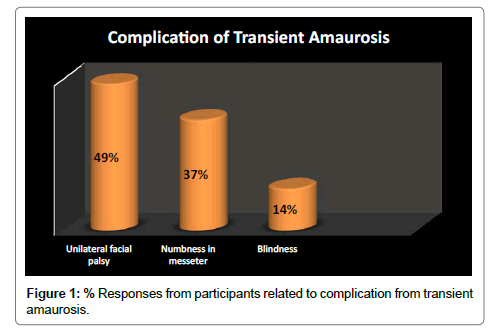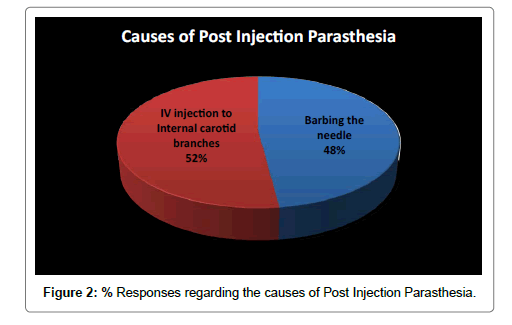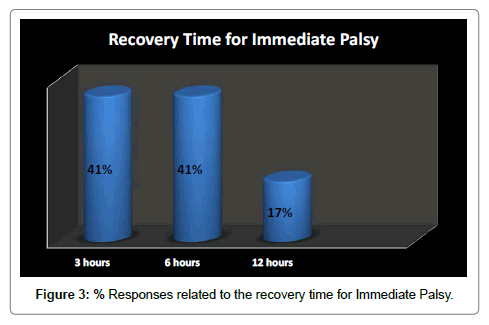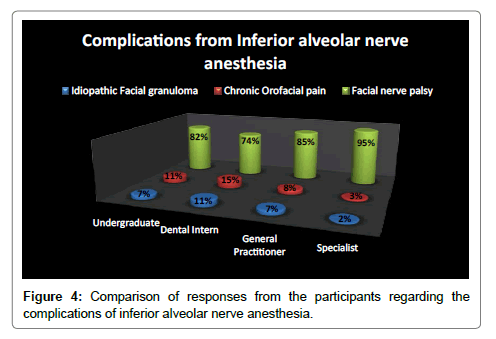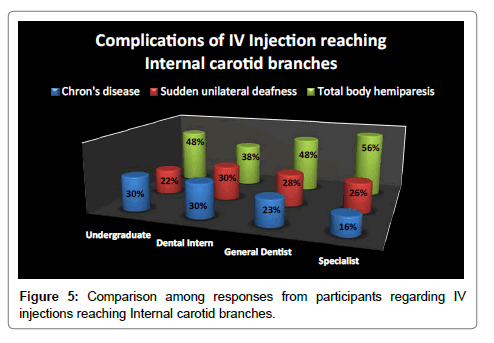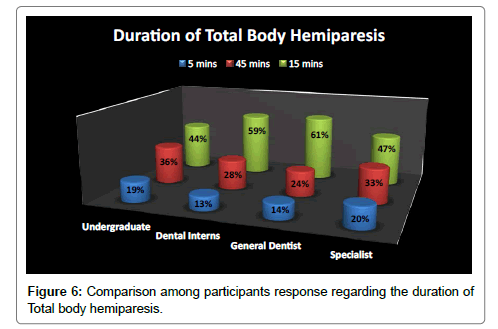Research Article Open Access
Awareness and Knowledge of Neurological Complications While Administering Local Anesthesia among the Dental Professionals of Riyadh
Aboras Husaam*, Al-Ali N, Al-Omair T, Al-asmari A, Al-jrais M, Al-rizqi M, Al-arnous N, Shaikh SP and Ansari SHRiyadh Dental Schools, Riyadh, Saudi Arabia
- *Corresponding Author:
- Aburas H, BDS
Riyadh Dental Schools
Riyadh, Saudi Arabia
Tel: +966533302030
E-mail: hs-hs0@hotmail.com
Received Date: November 20, 2016; Accepted Date: December 22, 2016; Published Date: December 30, 2016
Citation: Husaam A, Al-Ali N, Al-Omair T, Al-asmari A, Al-jrais M, et al. (2016) Awareness and Knowledge of Neurological Complications While Administering Local Anesthesia among the Dental Professionals of Riyadh. Pediatr Dent Care 1: 128.
Copyright: © 2016 Husaam A, et al. This is an open-access article distributed under the terms of the Creative Commons Attribution License, which permits unrestricted use, distribution, and reproduction in any medium, provided the original author and source are credited.
Visit for more related articles at Neonatal and Pediatric Medicine
Abstract
Aim of this study is to make sure that the dental professionals and students are aware of the complications which may occur to their patients and act accordingly in this situation. Examples of complications covered are facial nerve palsy, transient amaurosis, post-injection paraesthesia, Horner’s syndrome, transient paralysis of combined cranial nerves III, IV and VI, sudden unilateral deafness and abducens nerve palsy.
Keywords
Neurological; Complication; Local anesthesia; Dentistry
Introduction
The history of regional anesthesia and pain management is filled with fabulous stories and great characters. Ancient Egyptians used a variety of analgesics including hyoscyamine, scopolamine, opium poppy, beer, juniper, and yeast to treat a variety of ailments. Hippocrates (460-360 BC) believed in the healing power of nature and Indian culture used herbal medicine and yoga to overcome pain [1].
The benefits of Local anesthesia for your patients are often quite obvious as you take a patient in excruciating pain and make them comfortable during dental procedures. Local anesthesia in dentistry involves the injection or application of an anesthetic drug to peripheral nerves which supply the entire oral cavity. These medicines are given by injection to numb and provide pain relief to some part of the body dental procedures. They are given only by a trained dental care professional and only in a doctor’s office or a hospital [2]. Care should be taken when administering any local anesthetic agent especially when it comes to dosage; as there is a risk of attaining a few complications that are linked to less needed over dosage of the anesthetic [3].
The hypothesis say that inserting a foreign body into our body may bring risk of complications , this also goes with local anesthesia ,and the complications as well, such as nerve trauma; vascular injury; intravascular, intra glandular or intra muscular injection; and, as recently reported, middle-ear and ophthalmic problems. Consequences of misdirected needle placement include facial paralysis, inferior alveolar and lingual nerve paresthesia (transient or permanent) and muscle trismus among others. Neurological complications following the administration of a local anesthetic should be kept in mind [4]. Local anesthetic related ophthalmic complications have been reported in the past. Symptoms including diplopia, palpebral ptosis and blindness in some cases have been witnessed [5].
Objectives of the Study
Inquire about the knowledge of dental professionals about the possible neurological complications from local anesthesia.
Assess the knowledge of various levels of dental professionals based on their qualification and work experience and compare their knowledge.
Materials and Methods
A well designed questionnaire was used to collect data from 418 dental students from various dental schools of Riyadh. The data was then subjected to statistical analysis using SPSS. Responses were retrieved from undergraduate final year students, dental interns, general practitioners and specialists. The questionnaire included the questions related to the knowledge regarding facial palsy, total body hemiparesis, deafness, post injection paresthesia, orofacial pain as well as other related complications. The surveys were collected from Riyadh Colleges of Dentistry and Pharmacy and private dental clinics in Riyadh city.
Results
A total number of 450 questionnaires were sent to various departments of dental schools in Riyadh. The response rate was 92% with 418 questionnaires successfully returned. Male participants were 59% whereas 41% were females. We requested the participation of final year undergraduate students, interns, general practitioners and specialists (Tables 1-5 and Figures 1-6).
| Sl. No. | Level of education/experience | Percentage |
|---|---|---|
| 1 | Undergraduate | 26% |
| 2 | Dental Intern | 22% |
| 3 | General practitioner | 45% |
| 4 | Specialist | 7% |
Table 1: Categories of dentists based on their qualification and experience.
| Sl. No. | Complications | % Response from participants |
|---|---|---|
| 1 | Facial nerve palsy | 82% |
| 2 | Idiopathic facial granuloma | 8% |
| 3 | Chronic orofacial pain | 10% |
Table 2: Responses related to the possible complications of inferior alveolar nerve block.
| Sl. No. | Response | % Response from participants |
|---|---|---|
| 1 | After several minutes | 60% |
| 2 | After several hours | 40% |
Table 3: What is the onset time of delayed palsy?
| Sl. No. | Response | % Response from participants |
|---|---|---|
| 1 | Total body hemiparesis | 46% |
| 2 | Chron’s diseases | 27% |
| 3 | Sudden unilateral deafness | 27% |
Table 4: Complications related to excess pressure of IV injection into internal carotid branches.
| Sl. No. | Response | % Response from participants |
|---|---|---|
| 1 | 5 minutes | 16% |
| 2 | 15 minutes | 55% |
| 3 | 45 minutes | 29% |
Table 5: The duration of effects from total body hemiparesis.
Discussion
This study was designed in order to achieve a clear comparison among the knowledge of dental professionals belonging to various levels. We reached out to final year undergraduate students, dental interns, general practitioners and specialists in different sub divisions of dentistry.
Anesthesia is being used by the dental professionals on a daily basis and the frequency and quantity depends upon the clinical procedure. There is a possibility of any provision of local anesthetic resulting in a complication. The aim of this study was to determine the extent of knowledge among various dental professionals. The complications that were focused in this research included different forms of facial nerve palsy, complications related to injections reaching to branches of internal carotid artery and other related disorders.
It was noticed that there was a significant lack of knowledge among undergraduate students and dental interns, whereas, specialists exhibited better knowledge along with a good percentage of general practitioners. It is evident from the results that the more experience a dentist gains as far as the clinics are concerned, better knowledge of local anesthetic complications are achieved.
A major limitation of this study was the less number of specialists recruited for the survey. A healthy number of participants could have been more helpful in order to compare the knowledge. There are positive prospects for this study to be continued and carried out in other cities of KSA, which will give us a much better detail of comparison among various dental professionals when it comes to their knowledge regarding neurological complications of local anesthetics.
Conclusions
The participants were generally unaware of most of the complications occurred after local anesthesia. Specialists had a better knowledge regarding some of the local anesthesia complications whereas undergraduate and dental interns had less amount of knowledge.
References
- Deschner B, Robards C, Somasundaram(2007) The history of local anesthesia. In: Textbook of Regional Anesthesia and Acute Pain Management. McGraw Hill Medical, New York, USA. 3-18.
- Blanton PL, Arthur HJ (2003) Avoiding complications in local anesthesia induction. Journal of American Dental Association 134.
- Daublander M, Mauller R, Lipp MD (1997) The incidence of complications associated with local anesthesia in dentistry. Anesthesia Progress 44.
- Crean J, Powis A (1999) Neurological Complications of Local Anesthetics in Dentistry. Dental Update, 26: 344-349.
- Diago MP, Bielsa JMS (2000) Opthalmologic complications after intra oral local anesthesia with atricaine. Elsevier; Oral Surgery, Oral Medicine, Oral Pathology, Oral Radiology and Endodontology90: 21-24.
Relevant Topics
- About the Journal
- Birth Complications
- Breastfeeding
- Bronchopulmonary Dysplasia
- Feeding Disorders
- Gestational diabetes
- Neonatal Anemia
- Neonatal Breastfeeding
- Neonatal Care
- Neonatal Disease
- Neonatal Drugs
- Neonatal Health
- Neonatal Infections
- Neonatal Intensive Care
- Neonatal Seizure
- Neonatal Sepsis
- Neonatal Stroke
- Newborn Jaundice
- Newborns Screening
- Premature Infants
- Sepsis in Neonatal
- Vaccines and Immunity for Newborns
Recommended Journals
Article Tools
Article Usage
- Total views: 3512
- [From(publication date):
specialissue-2016 - Apr 03, 2025] - Breakdown by view type
- HTML page views : 2657
- PDF downloads : 855

